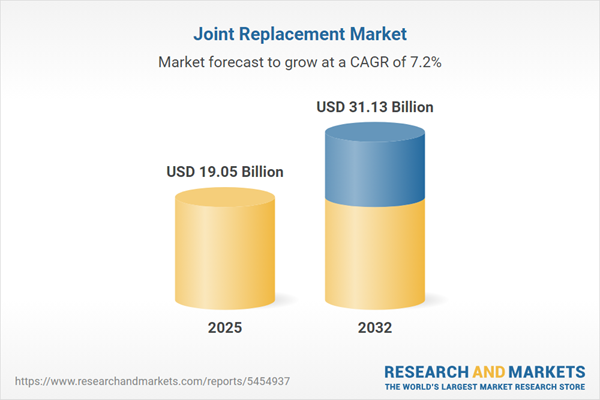Speak directly to the analyst to clarify any post sales queries you may have.
The joint replacement market is undergoing significant transformation, shaped by technological advancement, changing patient demographics, and evolving regulatory frameworks. Senior decision-makers are navigating an environment where innovation, automation, and efficiency are essential for scalable growth and sustainable competitiveness.
Market Snapshot: Joint Replacement Market Size and Growth Outlook
The global joint replacement market grew from USD 17.85 billion in 2024 to USD 19.05 billion in 2025, with projections showing ongoing expansion at a compound annual growth rate (CAGR) of 7.19%. The market is expected to reach USD 31.13 billion by 2032. This growth reflects increasing demand driven by demographic changes and a continuous stream of product and process innovation.
Scope & Segmentation
This report provides a comprehensive analysis of the joint replacement market, segmenting by procedure type, material, technology, and regional performance. It encompasses extensive competitive and regulatory coverage, highlighting emerging opportunities and evolving use-cases across the value chain.
- Joint Types: Includes hip, knee, and extremity joints (ankle, elbow, wrist).
- Implant Materials: Covers ceramics, metals (cobalt, nickel, titanium, zirconium), and polyethylene components.
- Fixation Techniques: Features cemented, cementless, and hybrid approaches, each impacting device integration and post-surgical outcomes.
- Applications: Focuses on replacements for arthritis, avascular necrosis, and degenerative joint diseases.
- End Users: Evaluates ambulatory surgical centers in parallel with hospitals and clinics.
- Regional Analysis: Assesses the Americas, Europe Middle East & Africa, and Asia-Pacific, including countries such as United States, Canada, Germany, China, and India.
- Key Companies: Profiles Acumed, Arthrex, B. Braun, ConMed, ConforMIS, Corin, Exactech, Johnson & Johnson, LimaCorporate, Mathys, Medacta, Medartis, MicroPort, Smith & Nephew, Stryker, Zimmer Biomet, and others.
Key Takeaways for Senior Decision-Makers
- Advancements in robotics, digital platforms, and augmented reality are accelerating innovation in implant design, surgical navigation, and patient-specific planning.
- Active and younger patient populations are driving demand for longer-lasting implants and technologies that support higher activity levels.
- Collaboration between device manufacturers and digital health providers is producing integrated solutions, combining hardware, software, and services for improved patient engagement.
- Regulatory authorities are increasingly prioritizing life-cycle management and international harmonization, prompting manufacturers to adapt development and compliance strategies.
- Differentiation is occurring through adoption of new materials, modularity, additive manufacturing, and smart implants capable of real-time physiological monitoring.
Evaluating the Impact of 2025 US Tariffs
The 2025 introduction of US tariffs is altering global supply chain dynamics for joint replacement devices. Higher duties on imported metals, ceramics, and related inputs are intensifying cost pressures and prompting manufacturers to diversify suppliers and explore nearshoring options. Companies are also adapting logistics and inventory management practices to preserve supply chain agility and offset delays from disrupted just-in-time processes. These strategies support margin protection and continued device availability, while regional pricing structures and contract negotiations evolve in response to increased operational complexity.
Methodology & Data Sources
Market insights are derived from primary interviews with orthopedic surgeons, hospital executives, device companies, and payers, complemented by secondary analyses of peer-reviewed publications, regulatory filings, and technical literature. Quantitative and qualitative findings were cross-validated through expert panel reviews and triangulation techniques, maintaining alignment with recognized research standards.
Why This Report Matters
- Senior leaders will gain actionable clarity on how to align R&D and product development with shifting market dynamics, patient expectations, and regulatory imperatives.
- In-depth segmentation and regional analysis facilitate targeted go-to-market planning and effective resource allocation across joint types, materials, and global markets.
- The examination of partnerships, supply chain adaptations, and reimbursement landscapes underscores practical strategies for enduring value creation and competitive advantage.
Conclusion
The joint replacement market is shifting rapidly, with technology, clinical practice, and regulation forming an environment rich in both opportunity and complexity. Organizations that invest in innovation, operational agility, and data-driven decision-making will be best positioned to meet stakeholder needs and capture future growth.
Additional Product Information:
- Purchase of this report includes 1 year online access with quarterly updates.
- This report can be updated on request. Please contact our Customer Experience team using the Ask a Question widget on our website.
Table of Contents
3. Executive Summary
4. Market Overview
7. Cumulative Impact of Artificial Intelligence 2025
List of Figures
Samples

LOADING...
Companies Mentioned
The key companies profiled in this Joint Replacement market report include:- Acumed, LLC
- Arthrex, Inc.
- B. Braun SE
- ConforMIS, Inc.
- ConMed Corporation
- Corin Ltd.
- Exactech, Inc.
- Implantcast GmbH
- Johnson & Johnson
- Lima Corporate S.p.A.
- LimaCorporate S.p.A.
- Mathys AG
- Medacta International S.A.
- Medartis AG
- MicroPort Orthopedics, Inc.
- MicroPort Scientific Corporation
- Smith & Nephew plc
- Stryker Corporation
- Zimmer Biomet Holdings, Inc.
Table Information
| Report Attribute | Details |
|---|---|
| No. of Pages | 189 |
| Published | October 2025 |
| Forecast Period | 2025 - 2032 |
| Estimated Market Value ( USD | $ 19.05 Billion |
| Forecasted Market Value ( USD | $ 31.13 Billion |
| Compound Annual Growth Rate | 7.1% |
| Regions Covered | Global |
| No. of Companies Mentioned | 20 |









